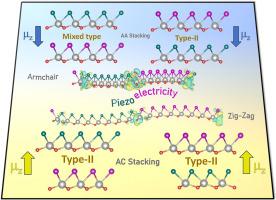Charge polarization-driven type-II band alignment and enhanced piezoelectricity in tin nitride halide heterostructures
IF 2.9
3区 物理与天体物理
Q3 NANOSCIENCE & NANOTECHNOLOGY
Physica E-low-dimensional Systems & Nanostructures
Pub Date : 2025-09-06
DOI:10.1016/j.physe.2025.116358
引用次数: 0
Abstract
In the quest for efficient energy conversion materials, we investigate piezoelectric properties of tin nitride halide (SnNX) through strategic design of vertical and lateral SnNCl/SnNBr heterostructures, using first-principles calculations. Two vertical configurations (HB-I and HB-II), based on the choice of the basal atomic layer (SnNBr or SnNCl), are studied with six stacking sequences featuring parallel and antiparallel orientations. The interlayer registry index highlights the dominant role of interface interactions in determining the energy landscape. HB-II configuration exhibits a type-II band alignment for all stacking orders (AA, AB, AC). While only the AC stacking order of HB-I displays a type-II band alignment, which correlates with the reversal in the direction of charge polarization. Lateral heterostructures composed of eight-unit cells of SnNCl and SnNBr [(SnNCl)8/(SnNBr)8] are also constructed along armchair and zigzag directions, revealing mixed band alignment at the interfaces. A comprehensive analysis indicates that interfacial charge polarization critically determines the piezoelectric response. The out-of-plane piezoelectric strain coefficient, reaches 90 p.m./V in the vertical heterostructure, comparable to leading bulk perovskites. Our findings provide a deeper understanding of band alignment and piezoelectricity in SnNCl/SnNBr heterostructures, paving the way for future experimental efforts to design advanced 2D energy conversion materials with tailored properties.

氮化锡卤化异质结构中电荷极化驱动的ii型带对准和增强的压电性
为了寻找高效的能量转换材料,我们利用第一性原理计算,通过对垂直和横向SnNCl/SnNBr异质结构的战略设计,研究了氮化锡卤化(SnNX)的压电性能。基于基原子层(SnNBr或SnNCl)的选择,研究了两种垂直构型(HB-I和HB-II),具有平行和反平行取向的6种堆叠序列。层间注册指数强调了界面相互作用在决定能源格局中的主导作用。HB-II结构在所有堆叠顺序(AA, AB, AC)下都呈现ii型波段对准。而只有HB-I的交流堆叠顺序呈现ii型波段对准,这与电荷极化方向的反转有关。由8单元SnNCl和SnNBr组成的横向异质结构[(SnNCl)8/(SnNBr)8]也沿扶手椅和之字形方向构建,在界面处显示混合带取向。综合分析表明,界面电荷极化是决定压电响应的关键因素。在垂直异质结构中,面外压电应变系数d33达到90pm /V,与领先的块状钙钛矿相当。我们的研究结果为SnNCl/SnNBr异质结构中的能带对准和压电性提供了更深入的理解,为未来设计具有定制性能的先进二维能量转换材料的实验工作铺平了道路。
本文章由计算机程序翻译,如有差异,请以英文原文为准。
求助全文
约1分钟内获得全文
求助全文
来源期刊
CiteScore
7.30
自引率
6.10%
发文量
356
审稿时长
65 days
期刊介绍:
Physica E: Low-dimensional systems and nanostructures contains papers and invited review articles on the fundamental and applied aspects of physics in low-dimensional electron systems, in semiconductor heterostructures, oxide interfaces, quantum wells and superlattices, quantum wires and dots, novel quantum states of matter such as topological insulators, and Weyl semimetals.
Both theoretical and experimental contributions are invited. Topics suitable for publication in this journal include spin related phenomena, optical and transport properties, many-body effects, integer and fractional quantum Hall effects, quantum spin Hall effect, single electron effects and devices, Majorana fermions, and other novel phenomena.
Keywords:
• topological insulators/superconductors, majorana fermions, Wyel semimetals;
• quantum and neuromorphic computing/quantum information physics and devices based on low dimensional systems;
• layered superconductivity, low dimensional systems with superconducting proximity effect;
• 2D materials such as transition metal dichalcogenides;
• oxide heterostructures including ZnO, SrTiO3 etc;
• carbon nanostructures (graphene, carbon nanotubes, diamond NV center, etc.)
• quantum wells and superlattices;
• quantum Hall effect, quantum spin Hall effect, quantum anomalous Hall effect;
• optical- and phonons-related phenomena;
• magnetic-semiconductor structures;
• charge/spin-, magnon-, skyrmion-, Cooper pair- and majorana fermion- transport and tunneling;
• ultra-fast nonlinear optical phenomena;
• novel devices and applications (such as high performance sensor, solar cell, etc);
• novel growth and fabrication techniques for nanostructures

 求助内容:
求助内容: 应助结果提醒方式:
应助结果提醒方式:


